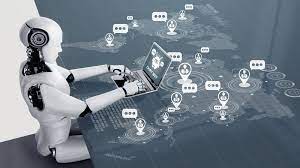Tech trends are rapidly changing the world. It is essential for leaders to stay on top of these changes so that they can quickly incorporate them into their business processes and remain competitive. Top New Technology Trends for 2023.
Some of the top new technology trends for 2023 include applied observability, which reduces customer downtime and security risks; and sustainable technologies like traceability, emissions management software and AI. These solutions improve energy efficiency, increase operational resiliency and enable enterprises to achieve their sustainability goals.

1. Artificial Intelligence
Artificial intelligence is an expansive technology that encompasses a variety of different algorithms and systems. These tools allow computers to mimic human intelligence by learning and solving problems independently. They are also able to recognize patterns and predict outcomes.
Many industries are incorporating AI into their operations in order to improve productivity and revenue.
Another example of AI in business is the use of machine learning to identify and prioritize customer needs.
One of the most noteworthy developments in AI is the development of explainable AI systems, which allow machines to provide human-readable descriptions of their decisions and actions. This is an important improvement in AI because it helps to reduce bias and improve accountability.
2. Digital Twins
A digital twin is a virtual representation of a physical thing, system or process that replicates its real-world counterpart. It’s a state-of-the-art technology that can enhance and improve data visualization and understanding, especially when combined with machine learning.
Some companies are starting to deploy digital twins across their entire supply chains, which could help them track and mitigate risks, improve operations, and even save money. For example, digital twins for cars can monitor and optimize the manufacturing processes that create them. They can also collect and store data on the vehicle over time to enable smoother customer service and support, while informing future product improvements.
Other companies are using digital twins to design large-scale buildings and offshore oil rigs. And construction firms are using them to digitally connect infrastructure like roads, railways, and public transit to optimize traffic flow and reduce energy consumption. Ultimately, digital twins will enable better decision-making and faster growth for enterprise businesses, especially as they evolve into the industrial metaverse. And, as the technology grows more sophisticated, it could even help businesses develop and test ideas in a safe, virtual environment before they invest in costly real-world testing.
3. The Editable World
The data required to create digital twins, train intelligent machines and create a metaverse will come from interconnected sensors, devices and infrastructure networks. IoT devices such as smart speakers, TVs, lights and door and window control systems will communicate with each other, share information and provide more personalized experiences.
They also include technologies such as blockchain and zero trust security that will make it easier to secure networks from hacks, data breaches and identity theft.
Modular, platform-based technologies will facilitate agility and help organizations respond rapidly to changes in market conditions. They will also make it easier to integrate new functionalities and scale operations. This will be a particularly important trend in areas that require highly specialized skills, such as cloud computing, industrializing machine learning and developing energy-efficient commercial fleets. However, talent shortages remain a significant barrier to many high-tech trends.
4. Metaverse
The Metaverse is a virtual world where people can do virtually anything. It was first introduced in 1992 when author Neal Stephenson wrote his book Snow Crash. VR video games like Roblox, Decentraland and Minecraft have made the concept more comprehensible. And when 12.3 million people tuned in for a Travis Scott virtual concert on Fortnite last year, the Metaverse became even more mainstream.
Some experts think the Metaverse is already here in the form of augmented reality (AR) and virtual reality (VR) headsets. Others see it in the form of collaborative technologies that allow employees to work together in 3D environments. For example, enterprise leaders have started to use the Metaverse to add an element of realism to remote work experiences, says technology writer Esther Shein.
Despite the hype, it will take time for the Metaverse to grow into its full potential. One big reason is the need for an ultra-dense, low-latency computing network. US-based data centre equipment provider Vertiv predicts that the Metaverse will require 5G speeds to function properly.
5. Sustainable Technology
The tech sector often feels at odds with the environmental world, as our technology-enabled way of life hogs non-renewable resources. However, many of the top new technologies can help to rebalance that equation.
Digitized operations can reduce waste and energy usage; 5G wireless technology, for example, uses around 90% less power than 4G networks. And, if companies focus on sustainability goals, they can win consumer and investor reward. For instance, Schneider Electric focuses on efficiency-as-a-service and generates revenue from helping its customers save energy and emissions.
The pursuit of sustainable technologies can also improve employee productivity. For example, millennials love working in eco-friendly environments with air purifiers that can prevent respiratory problems. And, if your company has a clean-air policy in place, you can attract talent and reduce turnover. Moreover, incorporating sustainability into technology can increase business resilience as you minimize operational costs and enhance asset utilization. In this way, businesses can remain more flexible in a rapidly changing landscape needs read more hear……





















